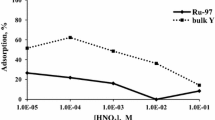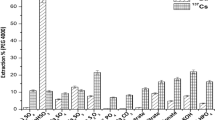Abstract
Calcium alginate (CA) hydrogel beads were prepared and used for the separation of 152Eu from trace and macro amounts of cesium. Best separation was achieved from 10−2 M HNO3, upon shaking 30 CA beads with the solution containing 152Eu and Cs for 20 min and then allowing a settle for further 10 min. Back extraction of europium without any contamination of Cs was successfully obtained after treating the 152Eu adsorbed CA beads with 0.1 M HNO3 and 1 M HNO3 solutions.







Similar content being viewed by others
References
Binjgham D, Dobrota M (1994) Distribution and escretion of lanthanides: comparison between europium salts and complexes. Biometals 7:142
Roberts SM, James RC, Williams PL (2015) Principles of toxicology: environmental and industrial applications. John Wiley and Sons, Inc., Hoboken
Metwally SS, Ayoub RR, Aly HF (2014) Utilization of low-cost sorbent for removal and separation of 134Cs, 60Co and 152+154Eu radionuclides from aqueous solution. J Radioanal Nucl Chem 302:441
Roy K, Paul R, Banerjee B, Lahiri S (2009) Extraction of long-lived radionuclides 152,154Eu and 134Cs using environmentally benign aqueous biphasic system. Radiochim Acta 97:637
Delacroix D, Guerre JP, Leblanc P, Hickman C (2002) Radionuclide and radiation protection data handbook, 2nd edn. Nuclear Technology Publishing, Ashford
Lahiri S, Roy K, Bhattacharya S, Maji S, Basu S (2005) Separation of 134Cs and 152Eu using inorganic ion exchangers, zirconium vanadate and ceric vanadate. Appl Radiat Isotopes 63:293
Lahiri S, Mukhopadhyay K, Nayak D (1999) Separation of heavy ion induced carrier free europium isotopes from bulk quantity of cesium. J Radioanal Nucl Chem 242:127
Nayak D, Lahiri S, Ramaswami A, Manohor SB, Das NR (1999) Production and separation of carrier-free 146,147Eu from a 12C6+ irradiated La2O3 matrix. Appl Radiat Isotopes 51:261
Lahiri S, Nayak D, Das NR (2000) Production and separation of carrier-free 145,146Eu from a CsNO3 target using a 16O beam. Appl Radiat Isotopes 52:1393
Maity S, Datta A, Lahiri S, Ganguly J (2015) Selective separation of 152Eu from a mixture of 152Eu and 137Cs using a chitosan based hydrogel. RSC Adv 5:89338
Maity S, Datta A, Lahiri S, Ganguly J (2016) A dynamic chitosan-based self-healing hydrogel with tunable morphology and its application as an isolating agent. RSC Adv 6:81060
Mirshafiey A, Khodadadi A, Rehm BH, Khorramizadeh MR, Eslami MB, Razavi A, Saadat F (2005) Sodium alginate as a novel therapeutic option in experimental colitis. J Immunol 61:316
Nestle N, Kimmich R (1996) Heavy metal uptake of alginate gels studied by NMR microscopy. Coll Surf A Physicochem Eng Asp 115:141
Veglio F, Esposito A, Reverberi AP (2002) Copper adsorption on calcium alginate beads: equilibrium pH-related models. Hydrometallurgy 65:43
Grant GT, Morris ER, Rees DA, Smitch PJC, Thom D (1973) Biological interactions between polysaccharides and divalent cations: the egg-box model. FEBS Lett 32:195
Bruchet M, Melman A (2015) Fabrication of patterned calcium cross-linked alginate hydrogel films and coatings through reductive cation exchange. Carbohydr Polym 131:57
Griffin DR, Kasko AM (2012) Photodegradablemacromers and hydrogels for live cell encapsulation and release. J Am Chem Soc 134:13103
Jin Z, Guven G, Bocharova V, Halamek J, Tokarev I, Minko S, Melman A, Mandler D, Katz E (2011) Electrochemically controlled drug-mimicking protein release from iron-alginate thin-films associated with an electrode. ACS Appl Mater Interfaces 4:466
Nayak D, Lahiri S (2006) Biosorption of toxic, heavy, no-carrier added radionuclides by calcium alginate beads. J Radioanal Nucl Chem 267:59
Mondal A, Lahiri S (2011) Separation of 134Cs and 133Ba radionuclides by calcium alginate beads. J Radioanal Nucl Chem 290:115
Banerjee A, Nayak D, Lahiri S (2007) Speciation-dependent studies on removal of arsenic by iron-doped calcium alginate beads. Appl Radiat Isotopes 65:769
Nayak D, Banerjee A, Lahiri S (2007) Separation of no-carrier-added 66,67Ga produced in heavy ion-induced cobalt target using alginate biopolymers. Appl Rad Isotopes 65:891
Nayak D, Lahiri S, Mukhopadhyay A, Pal R (2003) Application of tracer packet technique to the study of the bio-sorption of heavy and toxic metal radionuclides by algae. J Radioanal Nucl Chem 256:535
Nayak D, Banerjee A, Roy S, Lahiri S (2007) Speciation dependent studies on chromium absorption using calcium alginate and iron doped calcium alginate biopolymer. J Radioanal Nucl Chem 274:219
Gok C, Aytas S (2009) Biosorption of uranium(VI) from aqueous solution using calcium alginate beads. J Hazard Mater 168:369
Jang LK, Nguyen D, Geesey GG (1999) Selectivity of alginate gel for Cu over Zn when acidic conditions prevail. Water Res 33:2817
Konichi Y, Asai S, Midoh Y, Oku M (1993) Recovery of zinc, cadmium, and lanthanum by biopolymer gel particles of alginic acid. Sep Sci Technol 28:1691
Mimura H, Ohta H, Akiba K, Onodera Y (2001) Uptake behavior of americium on alginic acid and alginate polymer gels. J Radionanal Nucl Chem 247:33
Fuks L, Oszczak A, Gniazdowska E, Sternik D (2015) Calcium alginate and chitosan as potential sorbents for strontiumradionuclide. J Radionanal Nucl Chem 304:15
Fadl FIAE (2014) Radiation grafting of ionically crosslinked alginate/chitosan beads with acrylic acid for lead sorption. J Radionanal Nucl Chem 301:529
Yu S-L, Dai Y, Cao X-H, Zhang Z-B, Liu Y-H, Ma H-J, Xiao S-J, Lai Z-J, Chen H-J, Zheng Z-Y, Le Z-G (2016) Adsorption of uranium(VI) from aqueous solution using a novelmagnetic hydrothermal cross-linking chitosan. J Radionanal Nucl Chem 310:651
Bampaiti A, Yusan S, Aytas S, Pavlidou E, Noli F (2016) Investigation of uranium biosorption from aqueous solutions by Dictyopterispolypodioides brown algae. J Radionanal Nucl Chem 307:1335
Keshtkar AR, Mohammadi M, Moosavian MA (2015) Equilibrium biosorption studies of wastewater U(VI), Cu(II)and Ni(II) by the brown alga Cystoseiraindica in single, binaryand ternary metal systems. J Radionanal Nucl Chem 303:363
Sarkar K, Ansari Z, Sen K (2016) Detoxification of Hg(II) from aqueous and enzyme media: pristine vs. tailored calcium alginate hydrogels. Int J Biol Macromol 91:165
Cao Y, Shen X, Chen Y, Guo J, Chen Q, Jiang X (2005) pH-induced self-assembly and capsules of sodium alginate. Biomacromolecules 6:2189
PatricioIbáňz J, Umetsu Y (2002) Potential of protonated alginate beads for heavy metals uptake. Hydrometallurgy 64:89
Yin Y, Ji X, Dong H, Ying Y, Zheng H (2008) Study of the swelling dynamics with overshooting effect of hydrogels based on sodium alginate-g-acrylic acid. Carbohydr Polym 7:682
Greenwood NN, Earnshaw A (1989) Chemistry of the elements. In: Maxwell Macmillan international editions. Pergamon Press, Oxford
Shen Y, Xu S, He D (2015) A novel europium chelate coated nanosphere for time-resolved fluorescence immunoassay. PLoS ONE. doi:10.1371/journal.pone.0129689
Juntunen E, Myyryläinen T, Salminen T, Soukka T, Pettersson K (2012) Performance of fluorescent europium(III) nanoparticles and colloidal gold reporters in lateral flow bioaffinity assay. Anal Biochem 428:31
Acknowledgements
One of the authors (Kangkana Sarkar) gratefully acknowledges the University Grants Commission (UGC) for providing necessary fellowship. This work is a part of SINP-DAE 12 Five years plan project Trace and Ultratrace Analysis and Isotope Production (TULIP).
Author information
Authors and Affiliations
Corresponding author
Rights and permissions
About this article
Cite this article
Sarkar, K., Sen, K. & Lahiri, S. Separation of long-lived 152Eu radioisotopes from a binary mixture of 152Eu and 134Cs by calcium alginate: a green technique. J Radioanal Nucl Chem 311, 2001–2006 (2017). https://doi.org/10.1007/s10967-017-5176-3
Received:
Published:
Issue Date:
DOI: https://doi.org/10.1007/s10967-017-5176-3




